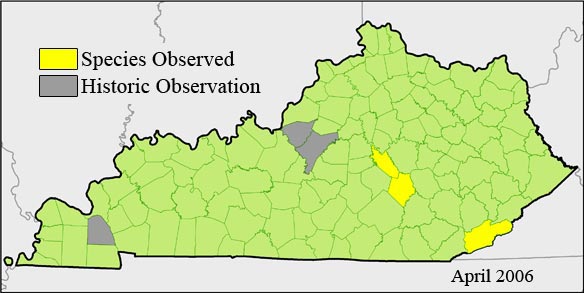P�h�o�t�o� �b�y� �U�n�i�v�e�r�s�i�t�y� �o�f� �T�e�n�n�e�s�s�e�e� �H�e�r�b�a�r�i�u�m� �(�T�E�N�N�)�
|
Habitat:
Rich, moist woods, thickets and woodland borders.
|
Species Description:
Perennial herb.
|
Phenology:
Flowering Period: Early July to late August.
Fruiting Period: Mid July to late October.
|
Additional Information at NatureServe
|
Diagnostic Characteristics:
Leaflets 3-9 with glands on the lower surface; rachis (the leaf axis/stem) with glandular and long non-glandular hairs. The hypanthium (the solid cup part of the fruit) 3-5 mm in length and bristles associated with the frt over 2.5 mm long, roots lacking fusiform tubers.Species is difficult to identify in vegetative state.
|
Management:
Exotic pest plants are a threat to this species.
|
Global Range:
Southern British Columbia to California, Arizona, and New Mexico; North Dakota to Nova Scotia, south to Georgia and Louisiana (Kartesz 1999). Species has been reported from the following provinces and states: British Columbia, Manitoba, New Brunswick, Nova Scotia, Ontario, Prince Edward Island, Quebec, Alabama, Arizona, California, Connecticut, Delaware, Georgia, Illinois, Indiana, Iowa, Kansas, Kentucky, Louisiana, Maine, Maryland, Massachusetts, Michigan, Minnesota, Missouri, Nebraska, New Hampshire, New Jersey, New Mexico, New York, North Carolina, North Dakota, Ohio, Oregon, Pennsylvania, Rhode Island, South Carolina, South Dakota, Tennessee, Vermont, Virginia, Washington, West Virginia, Wisconsin, and Wyoming (Scoggan 1978, USDA-NRCS 1999, Kartesz 1999). Kartesz (1999) considers reports from Montana, Utah, Colorado, and Arkansas to be false, does not recognize the species to be extant in Manitoba, but recognizes it in Mississippi.
More detailed range information was available for the following provinces and states.
British Columbia: occurs in southern portion of B.C. (G. Douglas pers. comm.).
Manitoba: occurs in southern 1/8 of Manitoba (12% of area of Manitoba) (E. Punter pers. comm.).
Scoggan (1957, 1978) and Kartesz (1999) do not recognize the occurrence of Agrimonia gryposepala in Manitoba, however, the identity of specimens of A. gryposepala collected in Manitoba housed in the herbarium at the University of Manitoba (WIN) were recently confirmed by E. Punter, Special Projects Botanist with the Manitoba Conservation Data Centre (E. Punter pers. comm.).
Ontario: common and widespread throughout southern and central Ontario (north to Manitoulin Island and Algonquin Park); not sure of northern limits (M. Oldham pers. comm.).
Quebec: occurs in southern portion of Quebec including Lower Laurentides, Region of Montreal, Eastern Townships, up to the Quebec City area (Rousseau 1974). The species is absent from the Gasp? Peninsula and the Saguenay-Lake St. John area. However, Agrimonia striata, which is frequently misidentified as A. gryposepala, is present in these two regions (J. Labrecque pers. comm.).
Arizona: Mogollon Rim from Flagstaff area east to Whiteriver on the Fort Apache Reservation south to Sierra Ancha Mountains; Coconino, Gila, and Navajo Counties (Arizona Heritage Data Management System).
California: 150-1700 m in northwestern California, the high Cascade ranges, the northern high elevation Sierra Nevada, the San Bernardinos, and the Peninsular Ranges (California Natural Diversity Database).
Delaware: piedmont and Newcastle county, infrequently occurs on the coastal plain (Delaware Natural Heritage Program).
Florida: occurs throughout the state (Wunderlin et al. 1995).
Georgia: recorded in one county in far north of state (USDA-NRCS 1999).
Illinois: occurs statewide (W. McClain pers. comm.).
Indiana: occurs in northern half of state (Indiana Natural Heritage Data Center).
Iowa: infrequent in south half of state, frequent to common elsewhere (Iowa Department of Natural Resources).
Kansas: known from a single historical collection from Marshall County (C. Freeman pers. comm.).
Kentucky: found in 4 counties in the central and eastern portions of the state (USDA-NRCS 1999).
Louisiana: one known population in Caddo Parish (Louisiana Natural Heritage Program).
Massachusetts: occurs throughout the state (USDA-NRCS 1999).
Maine: occurs in every county in the state (Haines and Vining 1998, Maine Natural Areas Program).
Michigan: occurs throughout the state (Michigan Natural Features Inventory).
Missouri: scattered locations, mostly in northern Missouri (T. Smith pers. comm.).
Montana: not previously known to occur here, specimens have been sent for identification verification (Montana Natural Heritage Program).
North Dakota: recorded in 2 counties in the state (USDA-NRCS 1999).
New Mexico: occurs in San Miguel county (New Mexico Natural Heritage Program, Martin and Hutchins 1980-81).
New York: found throughout the state (S. Young pers. comm.).
North Carolina: known to occur in 10 of 13 mountain counties (J. Amoroso pers. comm.).
Ohio: throughout the state, but particularly frequent on the Appalachian Plateau (A. Cusick pers. comm.).
Rhode Island: recorded in at least 2 counties in the state (USDA-NRCS 1999).
South Dakota: found in the northern Black Hills, and in south-central South Dakota; Lawrence, Pennington, Meade, and Todd counties (D. Ode pers. comm.).
South Carolina: occurs in 6 counties in the northern and eastern parts of the state (Boyle et al.).
Tennessee: occurs in 2 counties in the northeast portion of the state and 1 in the southeast (APSU Center for Field Biology and University of Tennessee Herbarium 1999).
Virginia: occurs in at least 43 counties throughout the state (USDA-NRCS 1999).
Vermont: occurs throughout the state (R. Popp pers. comm.).
Wisconsin: found throughout the state (Mason and Iltis 1958, K. Westad pers. comm.).
West Virginia: occurs in 18 counties in the state (USDA-NRCS 1999).
Wyoming: known to occur in Bear Lodge Mountains (Black Hills) of Crook County. One historical record from "Wind River" (Wind River Range or more likely Wind River Valley) in Fremont County (W. Fertig pers. comm.).
Confirmation was received that this species does not occur in Alberta (Alberta Natural Heritage Information Centre), Saskatchewan (Saskatchewan Conservation Data Centre), Alaska (Alaska Natural Heritage Program), Arkansas (Smith 1988; Arkansas Natural Heritage Program), Nevada (Nevada Natural Heritage Program), and Utah (Welsh et al. 1993; Utah Natural Heritage Program).
|
Known Kentucky Occurrences:

|
|